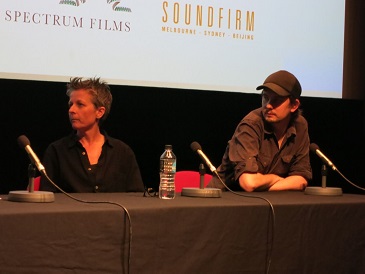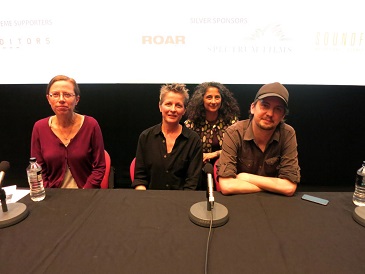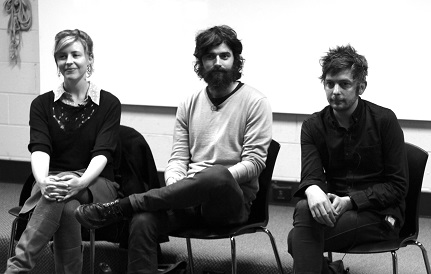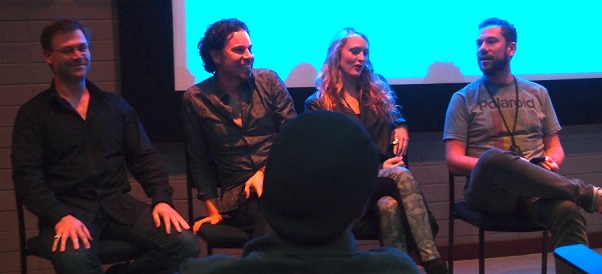DATELINE: Thursday October 10th 2013
THE MAIN EVENT: The Turning Q&A - NSW
VENUE: AFTRS Main Theatre
On the 10th of October in four states simultaneously, well almost, (Queensland held their’s the following evening), the ASE held a Q & A event with editors that worked on The Turning.
The Turning was a film event conceived and produced by Robert Connelly. Seventeen talented Australian directors from diverse artistic disciplines, created a chapter of the hauntingly beautiful novel by Tim Winton.
Each director was given the same budget but also complete freedom on how to interpret each chapter in approximately eleven minutes. Interestingly, no one had access to what each other were doing including which actors used, shooting and editing styles, music and sound.
The Turning event in NSW was held at The Australian Film and Television School. Karen Pearlman chaired this session with her usual inclusive informative style. She explored with the editors whether Connelly’s gamble paid off and how it was to work on such an unusual project.
The three guest speakers were Dany Cooper ASE, Rochelle Oshlack & Gabe Dowrick, and they had never seen each other's cuts before the final feature film was compiled. Each story explored relationships through time in very different Australian settings. Each editor showed a five minute clip.
Dany Cooper edited the chapter Reunion, directed by Simon Stone, written by Andrew Upton and had a stellar cast, Cate Blanchett, Richard Roxburgh and Robyn Nevin. It was shot in just 6 takes, using steadicam which followed the characters through the bland suburban setting on Christmas day. It was a fascinating but quick edit said Dany, ‘It was like watching an actor master class’. But she was also nervous of how their cut would work alongside the other chapters in terms of pacing and style.

Rochelle Oshlack edited Sand, directed by Stephen Page with an Aboriginal cast including Stephen’s two nephews who had never acted before: Jakory Blanco and Jarli-Russell. It also featured Blanco Kirk Page, Denis Thorne and Tyson Birtles.
An idyllic day at the beach is broken when sibling rivalry almost has tragic consequences. Rochelle created a beautifully paced cut that created excruciating tension as one boy lies in a sand tunnel built by his brother. The cut also makes poignant symbolic connections to the roles of initiation and land which Rochelle explored very successfully having worked on many Indigenous films.
An important subtle element used was the sound of sand. It played a key role in creating a very different mood for this story. Guy Gross and Rochelle collaborated constantly to create a very unique but subtle sound track.
The last panelist introduced was Gabe Dowrick, who edited the last chapter in the film called Defender. It was directed and written by actor Ian Meadows who Gabe had worked with before on his only other film, a short.
The cast included a very angry and unpredictable Dan Wyllie with Kate Mulvany, Gibson Nolte and Maddison Byfield.
An ambitious script, the rough cut was almost 30 minutes long. Gabe who is very modest has an interesting irreverence towards traditional cutting. He and Ian worked at getting the emotion and performances right, ‘continuity was thrown out the window’ he says. The result was a tense, at times claustrophobic cut that captured the charged emotions of their characters, following their intent rather than the geography of where and when.
Gabe says they decided not to end the film with a close up of the gun pointing straight to camera. It might be too much to shoot the audience.
Most of those in the audience had not seen the cinema release of the film and by the end of the evening, all had regretted missing a very interesting event. Supporting projects like this that take a risk and challenge everyone involved should be a priority in the safe cinema climate that exists at the present time.
All in all, a great night and big thank you to those that participated!
By Brianna Cook and Jane St Vincent Welch ASE
DATELINE: Thursday October 10th 2013
THE MAIN EVENT: The Turning Q&A - VICTORIA
VENUE: Swinburne University, Melbourne
The Turning is an Australian cinematic experience that sees a Tim Winton collection of short stories with an interweaving narrative turned into a feature film. Each chapter had its own director, crew and editor.
On Thursday the 10th of October the ASE’s Victorian branch held an event featuring three of the editors involved in this ambitious project as other ASE branches around the country were staging events with local editors and practitioners who worked on The Turning.
In Melbourne the Victorian night was held at Swinburne University and featured editors Billy Browne, Annabelle Johnson and Michael J Lutman. Cindy Clarkson as moderator kept the evening going with a steady stream of questions as well as encouraging the audience to participate. The editors were asked a range of questions from their first reactions to seeing The Turning at it’s world premiere in the 2013 Melbourne International Film Festival, through their connection with the material (only Michael had read the book prior to working on the film), through their relationships with their directors and their choice of editing software and workflow. Excerpts from Fog, Damaged Goods and Boner McPharlin’s Moll were shown and the editors talked about those particular scenes. The editors said that none of the cuts changed after the feature was put together. The chapters were graded and mixed independently though not all the editors could make them due to other work. Here’s what they said about their specific films
Fog – Billy Browne
Billy first of all talked about his surprise on seeing the film at MIFF – FOG being one of the first films made meant that nearly a year had passed since he worked on it. He joked that if he knew the overall length of The Turning was going to be three hours he would have made his shorter. He also talked about how amazingly well the films fitted together. Fog is a story about how a conflicted policeman embroiled in corruption must escort a young female journalist to locate a body in mountainous bush land covered by a hazy fog. Billy talked about director Jonathon auf de Heide’s love of mountains and how they used them and the fog to build a the suspense and sense of foreboding with the story. He also talked about how when editing he looks for performance and in this film edited together the best performance by the lead actor and built on that with reaction shots and the visuals of the mountains. His approach to editing is to find the natural point for a cut where it just feels right. He starts with the performance and adds the extras like music later. The film was shot on an Arriflex HD camera and edited on an Avid. Billy talked about his background using Lightworks and isn’t used to having layer upon layer of video tracks. He keeps copious hand written notes when he edits. When asked about whether he prefers drama to documentary he talked about how he primarily works on features but has worked in documentary and that it can be rewarding but is often overwhelming with the volume of material you have to work with. Finally when asked about his favourite experience on The Turning he cited working with director Jonathon auf de Heide and seeing how the final product came together.
Damaged Goods – Annabelle Johnson
Annabelle edited Damaged Goods directed by Anthony Lucas, well known for his work in animation. Her film was about a woman going through the past events in her husband’s life and seeing his previous attachments to ‘damaged goods’, questions her own role in his life. The film is entirely told in split screen – this was conceived at the script level and Annabelle had examples of the script to show us how it was set out. To test how this would work Annabelle and the director used footage from another project she was working on and used it split screen. They quickly discovered that cuts in split screen are much more jarring as you have your focus split so the decision was made for longer takes. It also used a combination of footage and black and white stills adding to the feeling of nostalgia. Due to the split screen nature of the cut both Annabelle and the director had active communication with the DOP explaining that they would be re-framing everything in the edit. Annabelle cut Damaged Goods on Final Cut Pro (v7). While working primarily in narrative features Annabelle also talked about the rewarding nature of documentary film making and crafting a story out of large volumes of real material. When asked what was her favourite experience working on The Turning she cited working with director Anthony Lucas and the experimental nature of Damaged Goods.
Boner McPharlin’s Moll – Michael J Lutman
Editor Michael J Lutman was working at the post house, The Butchery when he was recommended for The Turning. The director Justin Kurzel (Snowtown) did an intensive phone interview with him prior to deciding on him. Michael as an American was interested in the telling of this uniquely Australian story. Boner McPharlin’s Moll is a narrative based on rumours but done in a documentary style. It has seven different subjects and was cast with non-actors who gave real responses about their own experiences but with the names changed to fit the characters in The Turning. To add to this Boner McPharlin’s Moll was shot on 16mm film and was one of the last to be processed here in Australia (at Deluxe). In using film they shot less material than what they would have shooting digital. Boner McPharlin’s Moll had no music and was completely dialogue driven. When asked about his general editing methodology Michael said he tries to get the best moments on the time line first and then worries about where the edits go. He used an Avid and had made notes using the marker feature (colour coding for different aspects). On the question of narrative versus documentary Michael made the point that in narrative you can completely control the world you are working in whereas in documentary because you are dealing with actual people there are ethical constraints. When asked about his favourite experience working on The Turning Michael responded that it was getting to work with director Justin Kurzel and getting the opportunity to work with 16mm film.
Overall it was a really enjoyable and informative discussion that gave the audience an insight into this unique cinematic event. The ASE wish to thank producer/director Robert Connelly and producer Maggie Miles from Arena Media for allowing us to use footage from The Turning. Thanks also to Fahim Ahad for compiling and trans-coding the segments required for all four states. The Victorian branch would also like to thank Jill Holt for letting us use the facilities at Swinburne and taking the photos while arranging for Elvis to film the event. Finally thanks to Cindy Clarkson not only for her excellent work as moderator and organization of this event but also for coming up with the idea and then putting out the idea that the various state branches could have similar events running on the same day.
By Shan Jayaweera
DATELINE: Thursday October 10th 2013
THE MAIN EVENT: The Turning Q&A - WESTERN AUSTRALIA
VENUE: Edith Cowan University, Mt Lawley Campus
We had a good turn out of about 40 people. We had four panelists including one of the directors Claire McCarthy and cinematographer Denson Baker ACS as well as editors Beckett Broda and Merlin Cornish. They all offered great insights into their chapters and the film as a whole. Our audience was enthusiastic and very appreciative.
This is a remarkable film that not only showcases the wealth of filmmaking talent we have across Australia but also serves to bring the filmmaking community together as we did in this event.
Our sincere thanks for allowing us to celebrate their work in this way.
By Lawrie Silverstrin, WA Chair
DATELINE: Friday October 11th 2013
THE MAIN EVENT: The Turning Q&A - QUEENSLAND
VENUE: Griffith Film School, South Brisbane
The Queensland chapter of ASE held a special screening of the Immunity chapter from Tim Winton's The Turning at Griffith Film School on Friday evening 11th October. The screening was followed by a Q & A with the editor Geoff Lamb, D.O.P Bob Humphreys, and producer Alex Barnes. 40 people attended the event and included a mix of industry and FTV students. Many gathered afterwards at the nearby Ship Inn to further discuss the film and to network.
ASE Qld chapter committee member Axel Grigor opened the event with Chairman, Josh Dawson, informing everyone about the important role of the ASE and upcoming Brisbane International Film Festival events such as "A Conversation with Matt Villa", "Spotlight on Queensland Post", and a networking event with other local guilds at the State Library on the 16th November.
Associate Professor Trish FitzSimons, Griffith Film School's convenor of the Bachelor of Film and Screen Media Production, welcomed the filmmakers and guests and emphasised the importance of the connections between education institutions in supporting local production and that GFS provided initial studio testing space for Immunity; the need to support guilds such as the ASE; and expressed a view on how the Australian film industry is re-inventing itself.
Following a screening of the cinema trailer of The Turning, producer Alex Barnes introduced Immunity - chapter 16 of 17 in the overall film experience. Like several of the other directors involved in this unique film project, Immunity marked director Yaron Lifschitz first foray into filmmaking. (He's the CEO and Artistic Director of CIRCA.)
After Immunity screened, Axel Grigor commenced the Q & A with a number of questions. There were also many questions from the audience across the areas of editing, cinematography and producing. Geoff, Bob, and Alex explained how they first became involved with the project and the complexities of working on a film with such an abstract form of storytelling. There was no script so they had to be explore other ways of structuring the dance components Yaron wanted to capture. Realising that performances could not be replicated, four Arri Alexas were used during filming.
Working with a director who every step of way expressed his disinterest in defining a clear story, at first proved a big challenge for all of them, especially for Geoff. At the end of production, he was handed 10 hours of dance footage and faced the task of somehow narrowing it down to 10 minutes. With only minimal instructions from the director as to what he wanted to see in the film, Geoff at first found the process quite confusing.
The project was edited at Geoff's home on Avid Media Composer, with him producing around 20 slightly different versions before arriving at final cut. Due to the director's overseas commitments with C!rca, most of their collaboration took place over Skype and Vimeo.
Bob and Alex revealed how they initially pushed for a more realistic set but Yaron was intent on a more stylised look. The lighting was designed by a the lighting designer with C!rca Dance Company designer and it was shot in Brisbane's Judith Wright Centre over several days. Bob raised the issue of needing to tell a clear narrative story and for the film not be too abstract but the director was not interested, 'visual art is his thing.' However, they all commented that due to the nature of the project they were able to have more creative freedom.
The Immunity chapter event was successful and it was inspiring to listen to local filmmakers speak about their involvement on this unique national film production.
By Jeanette McGown




